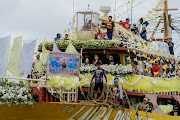Negros may forever be known as our country’s sugarbowl, but Chris Fadriga’s cacao farm in Bago City could very well be the reason why it would soon be famous for having the best chocolate in the Philippines. In 2021, Chris reached the totem of the artisanal chocolate world as his entry made the list of the Top 50 cacao beans, earning a gold rating in the prestigious International Cocoa Awards of the Cocoa of Excellence Programme. Out of 235 samples from the top producing regions around the globe, his heirloom Criollo cacao variety clearly stood out from the pack. The secret to its complex flavors and aroma is locked deep in its genetics, which could be traced as far back as 400 years ago when the Spanish Galleon Trade brought in the first seeds to be planted on Philippine soil.
Heirloom cacao farmer, Christopher “Chris” Fadriga inspecting a Criollo cacao fruit.
Criollo is considered the rarest and most valued variety of cacao, with its distinct white beans known to be flavorous rather than bitter, less acidic, and containing more of the flavonoids that promote holistic effects. Ancient civilizations like the Olmecs, Aztecs, and the Mayans specifically cultivated this variety to make a thick beverage sometimes mixed with mushrooms and chilies to be used in religious sacraments, served as a delicacy on royal occasions, and even as a currency that could be traded for gold. When the Spanish conquistadors made it into Mesoamerica, they immediately took note of the reverence given by the natives to these almond-shaped beans and soon enough started shipping them back to Spain. This was where sugar was first added to counter the bitterness before making its way to the rest of Europe, where they formulated it with milk and eventually molded it into bars to evolve into the chocolate we know today.
Chris Fadriga’s tablea pods made from the farm’s heirloom Criollo.
Through the centuries, demand for chocolate exponentially increased, causing commercial farmers to start favoring hardier varieties like Forastero and Trinitario which, compared to Criollo, provide higher yields and are less susceptible to natural diseases. This move drove Criollo cacao trees to near extinction. Despite many efforts these past few years by advocates like Chris Fadriga, Criollo still only makes up 5% of the world’s cacao production and is rarely used in commercial chocolate production. His search for heritage cacao began around a decade ago while working for a Japanese farmer who pointed him in the right direction. His passion brought him to the different corners of Negros, hunting for wild cacao pods in the hopes of finding the elusive white beans that signify the Criollo’s purity.
International award winning cacao farmer Chris Fadriga conducting a “bean cut test” to determine the variety of the cacao bean.
In time Chris was able to collect different cultivars from neighboring towns like Silay, Murcia, Don Salvador Benedicto, San Carlos, and La Castellana. Still unsatisfied, he took his search across Negrense waters to the Davao region, considered the country’s cacao mecca, with 81% of our annual production coming from here. As he hauled back the samples to his farm in Bago, Chris proceeded to graft and cultivate before anxiously awaiting the results of the harvest. As the pods were picked and the beans were cut to reveal their white centers, Chris knew he held in his hands a piece of our history compressed into this Criollo cacao bean, which is now recognized as one of the world’s best.
The Cocoa of Excellence Awards is a global competition that recognizes outstanding quality beans in terms of flavor, aroma, and appearance.
His international victory turned out to be bittersweet as Chris’s farm was struck by tragedy when super typhoon Odette ravaged his nursery, destroying most of his crops. Fortunately, some survived the worst of the storm and are now housed in strengthened structures to ensure their history pushes on. Though the Philippines is far from being on top of the global cacao industry in terms of quantity production, we have seen great strides in the areas of quality to put ourselves on the map. With people like Chris Fadriga, who continue to push the boundaries by scouring through the lineages of our heritage, it would only be a matter of time before the world takes notice of the richness of Philippine cacao.
Text By: Mayumi Espina
Photos and Video By: Bakunawa Films
Design and Architecture
Cultural Experience
Art and Craft
Food
People
BAO
-

Negros Season of Culture

Rooted. Taking on the World.
A global messaging system that promotes the cultural assets of Negros as shaped by its rich heritage and traditions, the unique identity of the place, and the talent of its people.
Popular Posts

Dinagsa Festival
Sunday, January 07, 2024

Chicken Ubad with Monggo (Chicken with Banana Pith and Mung Beans)
Thursday, July 15, 2021
Linutik
Friday, August 27, 2021
Rooted. Taking on the World.
Negros Season of Culture is a global messaging system that promotes the cultural assets of Negros as shaped by its rich heritage and traditions, the unique identity of the place, and the talent of its people.
Search This Site
Quick Links
People
Design and Architecture
Upcoming Events
Art and Craft
BAO
Food
Menu Footer Widget
Rooted. Taking on the World.
A global messaging system that promotes the cultural assets of Negros as shaped by its rich heritage and traditions, the unique identity of the place, and the talent of its people.
Search This Site
Upcoming Events
 Negros Season of Culture Celebrates National Heritage Month
Negros Season of Culture Celebrates National Heritage Month
The Negros Season of Culture Celebrates National Heritage Month this... Negros Season of Culture joins the National Commission on Culture and the Arts in celebrating National Heritage Month
Negros Season of Culture joins the National Commission on Culture and the Arts in celebrating National Heritage Month
Negros Season of Culture joins the National Commission on Culture...
Menu Footer Widget
• Copyright © -2021
- Negros Season of Culture







